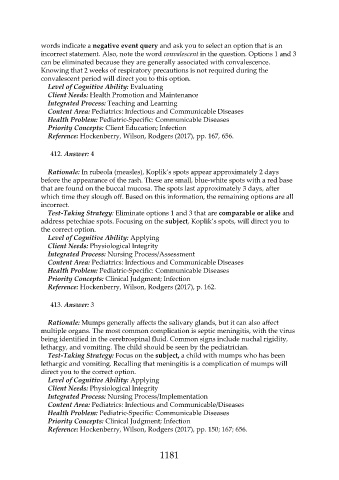Page 1181 - Saunders Comprehensive Review For NCLEX-RN
P. 1181
words indicate a negative event query and ask you to select an option that is an
incorrect statement. Also, note the word convalescent in the question. Options 1 and 3
can be eliminated because they are generally associated with convalescence.
Knowing that 2 weeks of respiratory precautions is not required during the
convalescent period will direct you to this option.
Level of Cognitive Ability: Evaluating
Client Needs: Health Promotion and Maintenance
Integrated Process: Teaching and Learning
Content Area: Pediatrics: Infectious and Communicable Diseases
Health Problem: Pediatric-Specific: Communicable Diseases
Priority Concepts: Client Education; Infection
Reference: Hockenberry, Wilson, Rodgers (2017), pp. 167, 656.
412. Answer: 4
Rationale: In rubeola (measles), Koplik’s spots appear approximately 2 days
before the appearance of the rash. These are small, blue-white spots with a red base
that are found on the buccal mucosa. The spots last approximately 3 days, after
which time they slough off. Based on this information, the remaining options are all
incorrect.
Test-Taking Strategy: Eliminate options 1 and 3 that are comparable or alike and
address petechiae spots. Focusing on the subject, Koplik’s spots, will direct you to
the correct option.
Level of Cognitive Ability: Applying
Client Needs: Physiological Integrity
Integrated Process: Nursing Process/Assessment
Content Area: Pediatrics: Infectious and Communicable Diseases
Health Problem: Pediatric-Specific: Communicable Diseases
Priority Concepts: Clinical Judgment; Infection
Reference: Hockenberry, Wilson, Rodgers (2017), p. 162.
413. Answer: 3
Rationale: Mumps generally affects the salivary glands, but it can also affect
multiple organs. The most common complication is septic meningitis, with the virus
being identified in the cerebrospinal fluid. Common signs include nuchal rigidity,
lethargy, and vomiting. The child should be seen by the pediatrician.
Test-Taking Strategy: Focus on the subject, a child with mumps who has been
lethargic and vomiting. Recalling that meningitis is a complication of mumps will
direct you to the correct option.
Level of Cognitive Ability: Applying
Client Needs: Physiological Integrity
Integrated Process: Nursing Process/Implementation
Content Area: Pediatrics: Infectious and Communicable/Diseases
Health Problem: Pediatric-Specific: Communicable Diseases
Priority Concepts: Clinical Judgment; Infection
Reference: Hockenberry, Wilson, Rodgers (2017), pp. 150; 167; 656.
1181

